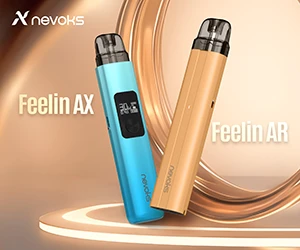There can be side effects to almost anything we add to our bodies, and vaping is no different. How vaping affects you depends on a lot of things, including how you vape, the vape juice you choose, the amount of nicotine it contains, and whether you smoked before you started vaping.
Vaping’s side effects are certainly not universal. Some vapers experience several, and others none at all. In the case of many of the side effects listed below, the experience only lasts as long as our bodies take to get used to a new habit. Others may not appear for some time or only in certain situations.
And, of course, some apparent side effects of vaping could actually be the side effects of quitting smoking.
When compiling this list of common vaping side effects, we looked at as many medical opinions as possible, trawled through vaping forums and discussion groups, and reached into the years of combined vaping experience of the Versed Vaper team.
Based on that research, here are the 10 most common side effects of vaping.
Coughing
It shouldn’t really be surprising that inhaling something into our lungs causes coughing and that this is one of the most commonly reported side effects of vaping. Even long-time smokers who switch to vaping can experience coughing, at least in the short term.
That said, coughing when vaping is likely caused by user error rather than some irritant in the inhaled vapor. Using a poor-quality vape liquid, letting the coil burn, or having the power setting too high are all common reasons why vaping makes us cough.
Coughing as a side effect of vaping seems to be, for the most part, a short-term problem. As our throat becomes used to the vapor and we learn how much to inhale and how to set up the vape correctly, coughing should become less of a problem.
You can also try switching to a liquid with a higher VG percentage, as this can provide a smoother hit than a high PG liquid.
Dry Mouth/Nose/Throat
A dry mouth, nose, or throat is usually caused by the ingredients used in vape juice, specifically the Propylene Glycol (or PG) and, to a lesser degree, the Vegetable Glycerine (VG). These base substances, used in vape liquids in various ratios, are both known to draw moisture from the surrounding environment. And in this situation, that means your mouth, nose, and throat.
Liquids that contain more PG are more likely to dehydrate you, but some vapers seem to experience this side effect just as much with high VG liquids. High PG combined with a high nicotine level also seems to cause a dry mouth/throat for some vapers.
The easiest way to avoid dry mouth, throat, or nose when vaping is to change your vape juice. If you use a 50/50 mix of PG and VG, switch to a liquid that uses 30% PG instead. The downside is that vape liquids with a higher PG ratio usually wick more efficiently, and have a more intense flavor. You’ll need to decide if losing these benefits is worth reducing this side effect. You could just rehydrate by drinking more water instead.
Headache
Headaches of varying severity are another commonly reported side effect for new vapers. They are most likely to occur at the end of the day, or after a period of vaping more intensively than usual.
Vape headaches are thought to be caused by both nicotine and the dehydrating effects of PG and VG. This is why they most often happen at the end of the day when both the nicotine and dehydration levels are potentially at their peak.
The method for preventing this vaping side effect will be different for everyone who experiences it. Changing to a vape liquid with a lower nicotine level will help some people, as could drinking more liquids throughout the day. Other vapers might need to take both steps to prevent headaches from ruining their day.
Persistent headaches can be a sign of many different ailments. If your headaches continue even after making the changes above, you should talk to a doctor.

Dizziness
A feeling of dizziness after vaping is another side effect reported by new vapers. Many describe it as similar to a headrush experienced after standing up too quickly or smoking their first cigarette.
Vapers are much more likely to experience dizziness if using vape juice with high nicotine content. Just like when smoking your first ever cigarette (or your first of the day), the sudden influx of nicotine causes a temporary imbalance in brain chemicals. Vapor is very efficient at delivering nicotine to the bloodstream, which is why even smokers who switch to vaping can have that new-smoker headrush.
This side effect is almost always temporary, subsiding as your brain gets used to the nicotine intake. If it continues for longer than a few days or you find the feeling unpleasant, simply changing to a lower-nicotine vape juice will usually help.
Tiredness
It isn’t so much that vaping makes you tired, but rather that nicotine intake can cause tiredness. Many other nicotine products can also have the same effect.
Nicotine can have both a stimulating and sedating effect on your brain, but not often in equal measure. Some people feel more stimulation while others feel more of the relaxative effect. Food, alcohol, medication, and the time of day can also change how the brain reacts to nicotine.
The obvious way to prevent tiredness from vaping is to vape less or reduce the nicotine level of your vape liquid. You could even consider switching to a nicotine-free vape liquid when you need to feel the most alert and awake.
Sore Throat
A persistent sore throat after vaping could be caused by several things, including high nicotine level, flavorings, coil temperature, or even the way that you vape.
Flavoring ingredients used in some liquids have been known to cause throat tissue irritation in some people. Just because something like licorice doesn’t affect you when you eat it doesn’t automatically mean it won’t affect you differently when vaped.
A coil that produces too much heat or burns because it is dry can also lead to a sore throat. You can usually taste a burnt coil pretty easily, but an overheating coil is not as easy to spot. Try reducing the power level on your vape to see if that helps.
Weight Loss or Gain
Some people have reported that vaping has helped them to gain or lose weight. This is unlikely to have been caused by the act of vaping itself, but rather as a result of a change in nicotine intake unbalancing your appetite levels.
Nicotine has long been known to act as an appetite suppressant. Dramatically reducing or increasing your intake is likely to be felt in the brain. If you have switched from smoking to vaping, you might feel like you use the vape as much as you used to smoke. Even if that is true, it doesn’t mean that the same amount of nicotine is being absorbed.
Another possible explanation for some people losing weight after taking up vaping could be their use of sweet, food-flavored vape liquids. It is not unreasonable to assume that, even without calories, a sweet taste in your mouth tricks your brain into thinking you have eaten something.

Increased Heart Rate
This is the other side of the tiredness side effect discussed above. For some people, nicotine is acts as a very strong stimulant. Because vaping delivers nicotine into the bloodstream very efficiently, it can be easy for inexperienced vapers to overindulge.
Reducing the nicotine strength of your vape juice can help, as can vaping less and not trying to chase huge clouds. If you are new to vaping, your body will become accustomed to the new way that nicotine is getting into your system and for most people, this will be a short-term side effect.
Of course, a racing heart or heart palpitations can also signify a much more serious underlying issue. If you experience it for a prolonged, period or when you aren’t actively vaping, talk to your doctor.
Stomach Ache or Cramps
Although not as commonly reported as many other vaping side effects, sometimes stomach aches or upsets are experienced by new vapers. Like several other symptoms listed here, this is less a side effect of vaping and more a side effect of nicotine.
Research has suggested that nicotine is a major cause of gastrointestinal disorders. Even relatively small quantities of nicotine directly entering the stomach and intestine can cause stomach cramps, nausea, and even diarrhea.
You can reduce the chance of spit-back (vape juice spitting into your mouth as it heats too quickly) by using a narrower or longer drip tip on your vape tank. Lowering the wattage and increasing the airflow can also help, as can changing to vape liquid with higher PG and lower nicotine strength.
Vaper’s Tongue
Vaper’s Tongue or Vaping Tongue is when your favorite ejuice suddenly loses flavor, no matter what coil, mod, or vape method you use. It is a side effect of using the same flavor of vape liquid for an extended period, along with dehydration, resulting in olfactory fatigue (or tired taste buds.)
You can easily solve your vaper’s tongue by switching to using a new, distinctly flavored vape juice for a while. When you go back to your favorite after a few days, it should taste as good as ever. Staying hydrated while you vape will help to prevent this problem in the first place, and also help to prevent other side effects in this list.
Long-Term Vs. Short-Term Side Effects
All of the side effects of vaping listed above are considered short-term. They can be avoided by changing your vaping habits or, in many cases, by reducing the nicotine level in your vape juice.
That is not to say that there aren’t possible long-term effects of vaping, because there undoubtedly are. Vaping is not a healthy habit, but it is almost certainly healthier than smoking cigarettes.
If you continue to suffer any of these side effects after making the suggested changes, we recommend seeking advice from a medical professional.
The bottom line
While vaping is a better alternative when compared with smoking combustible cigarettes, you may still experience some unpleasant side effects. Thankfully, these side effects are usually only experienced in the short-term, and by following the tips listed above, you can avoid some of them entirely. Also, keep in mind that some side effects that you may think are from vaping may really be side effects from quitting smoking.










Add comment